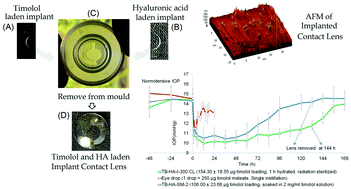Co-delivery of timolol and hyaluronic acid from semi-circular ring-implanted contact lenses for the treatment of glaucoma: in vitro and in vivo evaluation
Abstract
Glaucoma is a chronic disease, which is currently treated using frequent high dose applications of an eye drop solution; this method is tedious, and most of patients are non-compliant to it. Contact lenses are emerging as a convenient option to sustain the release of ophthalmic drugs. However, the incorporation of a drug/formulation changes the optical and physical properties of contact lenses. Contact lens users have also reported pink eye syndrome; this makes contact lenses unsuitable to be accepted as a medical device. The objective of the present study was to design novel timolol and hyaluronic acid (comfort agent)-loaded semi-circular ring-implanted contact lenses that could uphold the release at therapeutic rates without compromising the critical lens properties. The drug-loaded rings were individually implanted within the periphery of the contact lenses using modified cast-moulding technology. Atomic force microscopy showed an average roughness of 12.38 nm for the implanted lens that was significantly lower as compared to that of the Freshlook contact lenses (116.27 nm). A major amount of timolol was leached (from 46.47 to 58.79%) during the monomer extraction and moist sterilization (autoclave) steps; therefore, the lenses were sterilized by radiation and packaged under dry conditions (dehydrated). The in vitro release data showed sustained release of timolol and hyaluronic acid up to 96 h. The in vivo drug release study on rabbit eyes showed the presence of timolol in tear fluid up to 72 h. The in vivo pharmacodynamics studies showed a reduction in IOP till 144 h with a low drug loading (154 μg) as compared to the case of a single instillation eye drop solution (250 μg). This study has demonstrated the successful application of implantation technology to co-deliver timolol and hyaluronic acid from contact lenses for an extended period of time to treat glaucoma.



 Please wait while we load your content...
Please wait while we load your content...